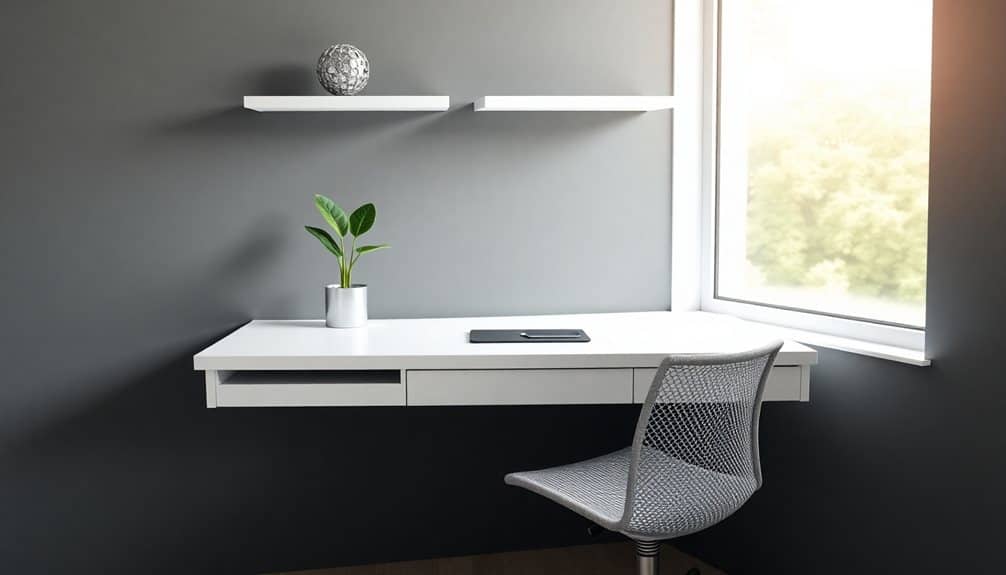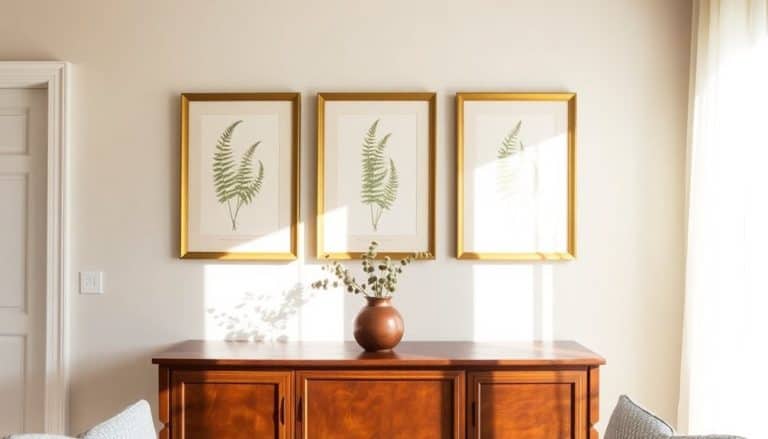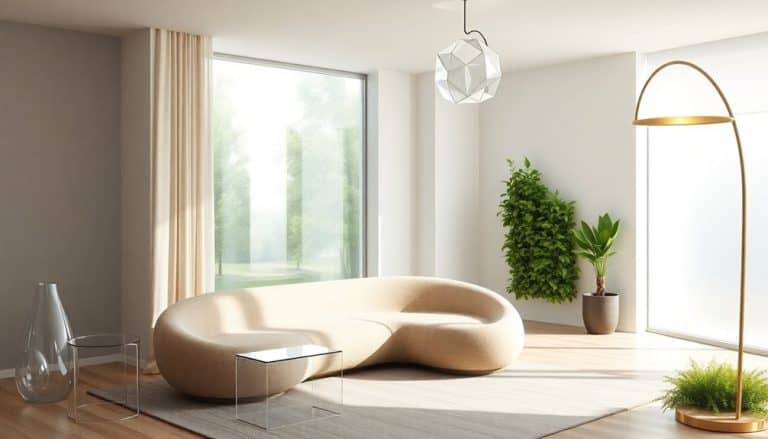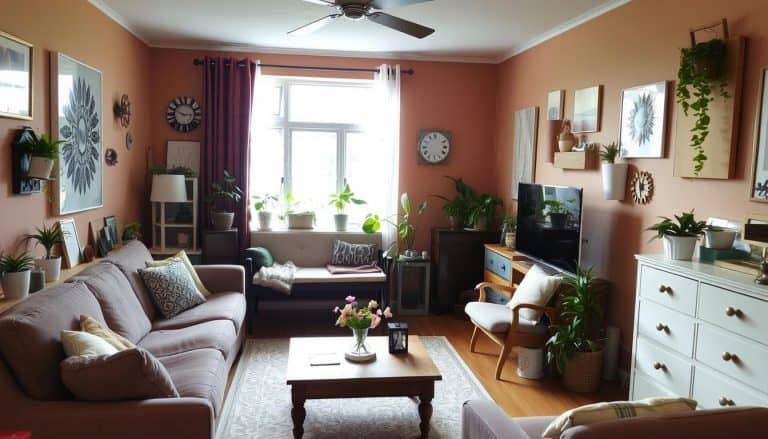This website contains affiliate links. Some products are gifted by the brand to test. As an Amazon Associate, I earn from qualifying purchases. The content on this website was created with the help of AI.
Your 2024 minimalist home office embraces a sophisticated monochrome palette while maximizing functionality through smart storage solutions. You’ll find peace in carefully curated spaces featuring height-adjustable furniture, wireless tech integration, and biophilic elements that bring nature indoors. Position your desk near windows to capture natural light, while statement pendant lighting adds dramatic flair to your workspace. Sustainable materials like bamboo and reclaimed wood merge seamlessly with ergonomic design principles, creating a productive haven. Discover how each thoughtfully selected element contributes to your workspace’s perfect balance of form and function.
Key Takeaways
- Integrate wireless technology and hidden charging solutions within minimalist furniture to maintain clean, cord-free surfaces throughout the workspace.
- Choose monochromatic color schemes with subtle tonal variations to create a sophisticated, distraction-free environment that enhances focus.
- Position desk near natural light sources and incorporate biophilic elements like plants to promote wellbeing while maintaining minimalist aesthetics.
- Select multifunctional furniture with built-in storage solutions to maximize space efficiency and reduce visual clutter.
- Install layered lighting with smart controls, combining task and ambient options while maintaining clean lines and modern simplicity.
The Essence of Monochrome

A monochrome color palette strips away the complexity from your home office, allowing you to focus on what matters most – productivity and peace of mind. By choosing varying shades of a single color, you’ll create a sophisticated space that’s both timeless and contemporary. Consider a gradient of grays, from charcoal to dove, or layers of warm whites that add depth without distraction.
Start with your walls as the foundation, selecting a matte finish in your base tone. Then, layer in furniture pieces that echo this choice – a sleek white desk paired with a light gray ergonomic chair creates visual harmony. You’ll want to incorporate texture through materials like brushed metal accents, woven textiles, and natural wood elements in similar tones.
Don’t forget the power of shadows and light in a monochrome space. Position your desk near natural light sources, and add strategic task lighting in matching metallic finishes. Complete the look with minimal artwork in black and white, and storage solutions in coordinating shades. The key is maintaining tonal consistency while introducing subtle variations that keep the eye moving smoothly through your workspace.
Smart Storage for Digital Nomads
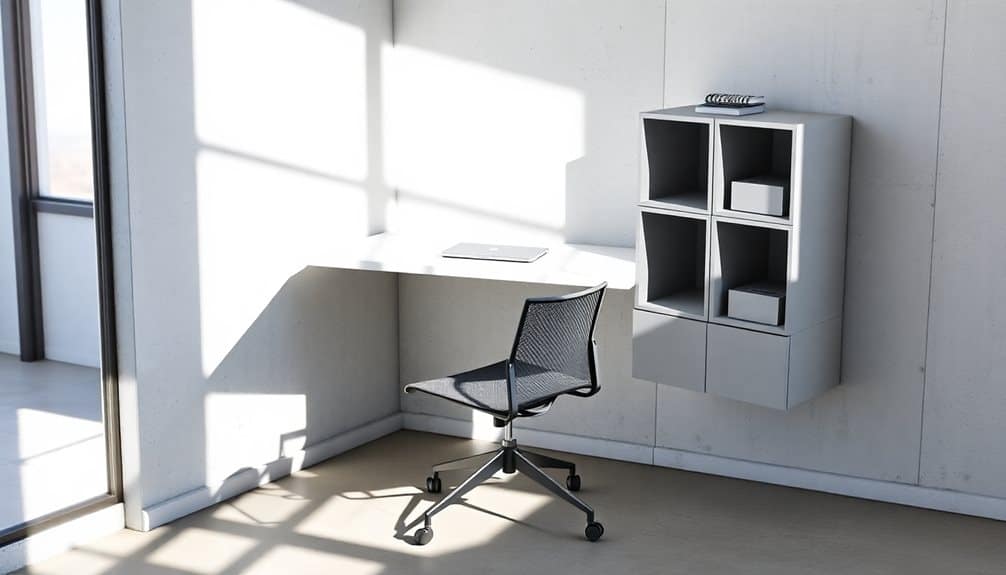
Digital nomads need to think outside the box when it comes to storage solutions, as space-saving functionality defines the modern mobile workspace. You’ll want to invest in collapsible file organizers and stackable containers that can easily shift between locations. Consider magnetic boards with detachable components that let you customize your setup while keeping essential items within arm’s reach.
Transform vertical space into storage gold with floating shelves that double as charging stations for your devices. Opt for desk organizers with built-in USB hubs and cable management systems to maintain a clutter-free environment. Modern storage pouches with RFID protection keep your tech accessories secure and organized during transit.
Look for furniture pieces that serve multiple purposes, like ottoman storage cubes that function as both seating and filing cabinets. Wall-mounted pegboards with interchangeable hooks and containers adapt to your changing needs, while slim rolling carts tucked under your desk create instant storage that moves with you. Choose clear acrylic organizers to maintain visual lightness in your space while keeping supplies visible and accessible. Install stylish wall-mounted hooks to hang backpacks and bags while maintaining your minimalist aesthetic.
Multifunctional Furniture Solutions
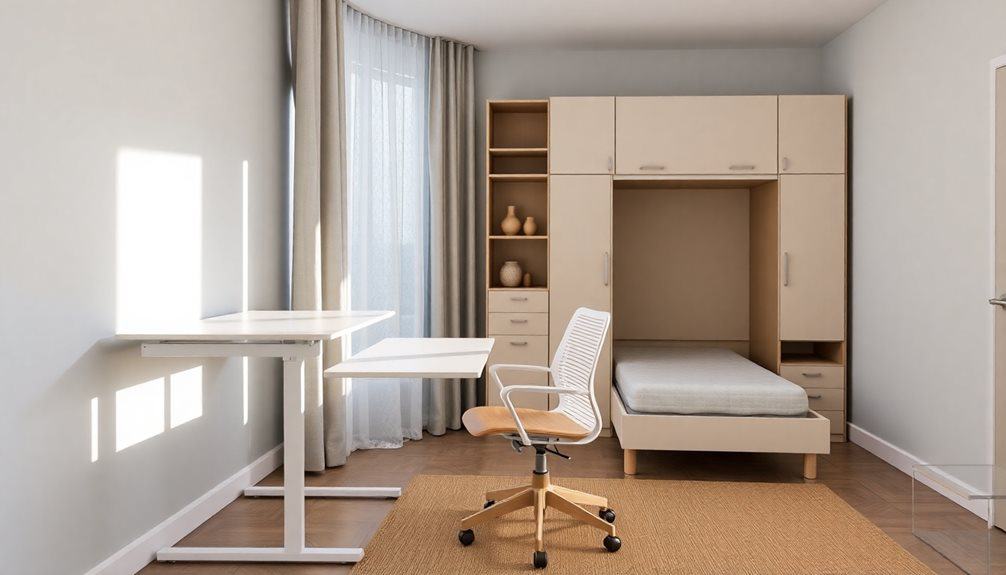
Modern home offices demand furniture that works twice as hard, seamlessly blending style with practicality. When you’re working with limited square footage, every piece needs to serve multiple purposes while maintaining a clean, minimalist aesthetic. Consider investing in transformable pieces that adapt to your changing needs throughout the day.
Sleek, modular solutions are trending in 2024’s home office designs, with furniture that shifts effortlessly between work and leisure modes. Look for desks with built-in charging stations and hidden storage compartments, or ottomans that double as file storage. Wall-mounted floating desks can fold away when not in use, instantly creating more floor space.
- Height-adjustable desk systems that convert from sitting to standing positions, featuring integrated power management and wireless charging pads
- Modular shelving units with removable desk attachments and customizable storage cubes that can be rearranged as needed
- Compact armchairs with swing-out laptop tables and storage compartments in the armrests, perfect for both focused work and relaxed reading
These versatile pieces guarantee your office space remains functional without sacrificing the sophisticated minimalism that defines contemporary design.
Biophilic Elements and Natural Light
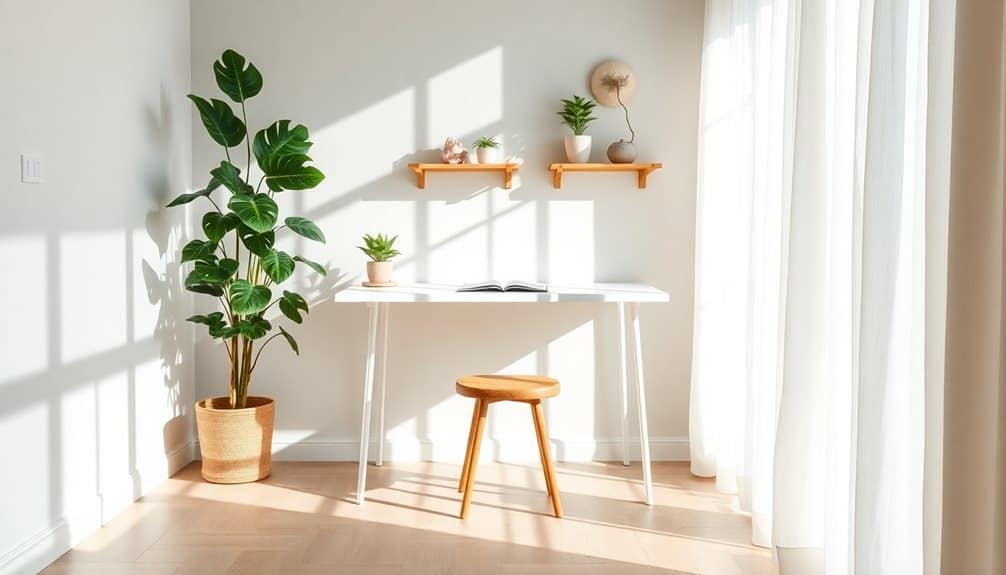
Bringing nature indoors has become essential for creating a balanced and energizing home office environment. You’ll want to position your desk near a window to maximize natural light exposure, which helps regulate your circadian rhythm and boost productivity. Consider installing sheer linen curtains that filter harsh sunlight while maintaining an airy atmosphere.
Integrate living plants strategically throughout your workspace – place trailing pothos on floating shelves, position a tall fiddle leaf fig in a corner, or mount air plants on your wall. You can also incorporate natural materials like bamboo desk accessories, cork bulletin boards, or a jute area rug to add organic textures.
To amplify natural light, use mirrors strategically – position them opposite windows to reflect daylight deeper into your space. Choose a color palette inspired by nature: sage green, warm sand, or soft sky blue. Don’t forget to include natural stone elements like marble coasters or agate bookends. If you’re dealing with limited natural light, opt for full-spectrum LED bulbs that mimic daylight and support your plants’ growth while maintaining the biophilic aesthetic. For an additional workspace that combines functionality with natural elements, consider adding a wooden potting bench repurposed as a standing desk or storage solution.
Minimalist Tech Integration

While natural elements create a calming foundation, a clutter-free approach to technology enhances your workspace’s serene atmosphere. Consider integrating your tech essentials through concealed charging stations, wireless solutions, and cable management systems that maintain visual harmony. You’ll find that sleek, minimal tech accessories in muted tones or metallic finishes complement rather than compete with your office aesthetic.
Transform your desk into a pristine workspace by embracing these minimalist tech solutions:
- Opt for a wireless charging pad integrated into your desk surface, eliminating visible cords while keeping devices powered
- Install a hideaway monitor arm that swivels out of sight when not in use, creating a clean backdrop for video calls
- Choose bluetooth peripherals in coordinating neutrals, featuring slim profiles and touch-sensitive controls
The key is selecting multifunctional devices that serve your needs while maintaining visual restraint. Consider a single ultra-wide monitor instead of multiple screens, or a compact all-in-one printer that tucks neatly into a cabinet. By prioritizing tech tools with minimalist design elements, you’ll create a sophisticated workspace that feels intentionally curated rather than overwhelmed by gadgets.
For optimal organization behind the scenes, implement tool-free assembly solutions for cable management and tech storage that can be easily adjusted as your setup evolves.
Purposeful Negative Space
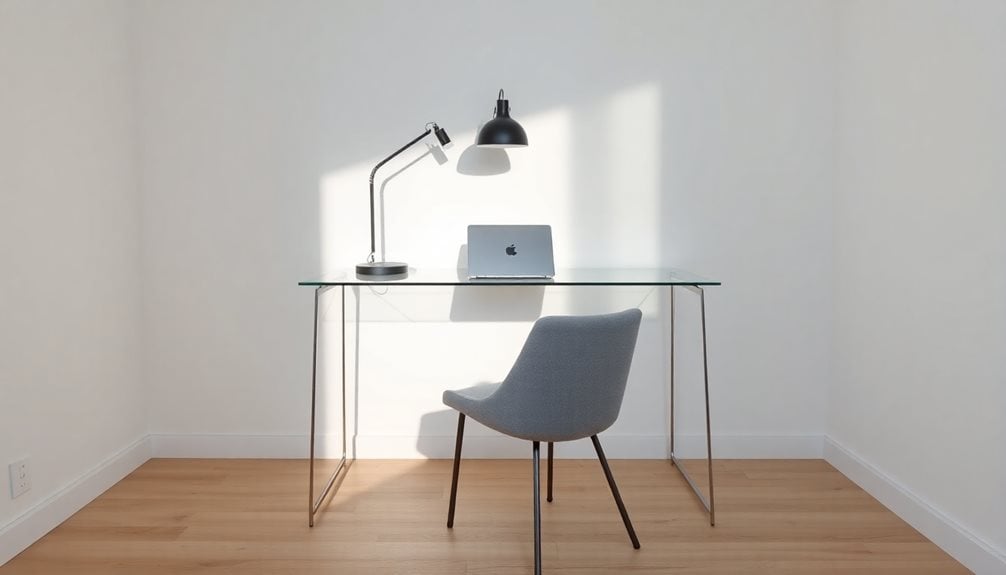
Empty spaces deserve as much attention as filled ones in a well-designed home office. Purposeful negative space creates visual breathing room and helps maintain mental clarity while you work. You’ll want to leave at least 40% of your wall space blank and maintain clear sightlines across your workspace to reduce visual clutter and cognitive load.
Consider the strategic placement of furniture with intentional gaps between pieces. A floating desk with open space underneath creates an airy feel, while leaving 24-30 inches of clearance around your chair promotes easy movement. Keep your desktop surface 50% clear, clustering essential items on one side to maintain an uncluttered workspace for tasks and creative thinking.
When positioning artwork or shelving, incorporate deliberate voids between elements. The rule of thirds helps here – imagine your walls divided into a 3×3 grid and place items at intersection points, leaving other sections empty. White space around windows should remain unobstructed to maximize natural light flow. Remember that negative space isn’t just empty – it’s an active design element that frames and enhances your productive environment.
Sustainable Materials and Finishes

Sustainable materials transform your home office into an eco-conscious sanctuary while elevating its aesthetic appeal. By selecting bamboo desktops, reclaimed wood shelving, and cork flooring, you’ll create a workspace that’s both environmentally responsible and visually striking. Today’s eco-friendly finishes offer sophisticated matte and semi-gloss options that rival traditional materials in durability and style.
When choosing sustainable materials for your office, focus on these key elements:
- Natural fiber textiles – Select organic cotton curtains, hemp upholstery, or wool rugs in neutral tones to add warmth while maintaining environmental integrity
- Recycled metal accents – Incorporate brushed aluminum desk accessories, copper light fixtures, or steel filing cabinets with low-VOC powder coating
- Bio-based finishes – Use non-toxic paints, natural oils, and water-based sealants that protect surfaces while ensuring healthy indoor air quality
You’ll find that sustainable materials often age beautifully, developing a rich patina that adds character to your space. Consider mixing FSC-certified hardwoods with recycled glass surfaces or combining bamboo elements with zero-VOC concrete countertops for a modern, eco-conscious aesthetic that’s built to last. For plant-friendly workspaces, incorporate coconut coir planters which provide excellent moisture retention while adding natural texture to your sustainable office design.
Ergonomic Design Principles
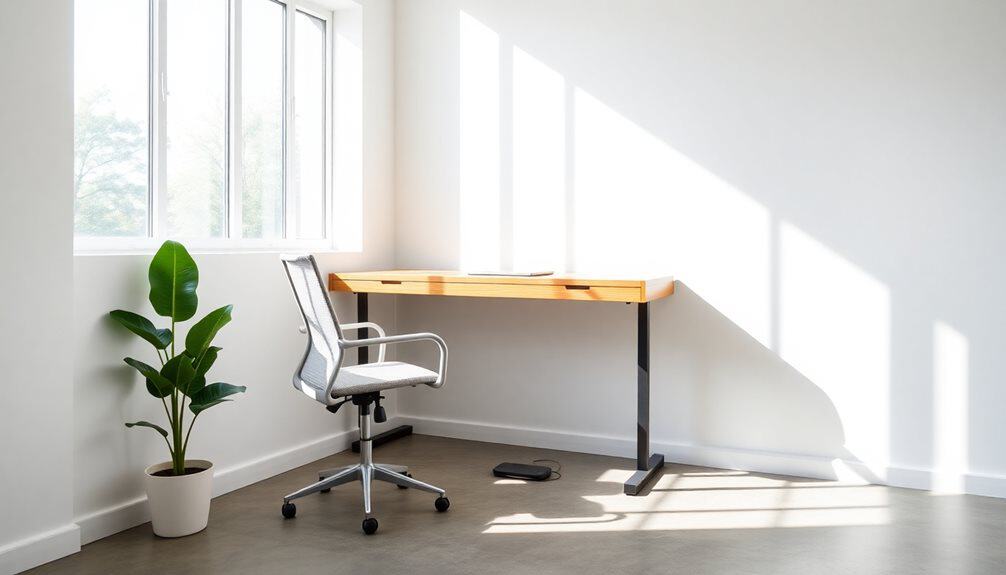
Creating a healthy workspace begins with three essential ergonomic principles: proper positioning, natural movement, and customizable support. Your desk height should allow your forearms to rest parallel to the floor, with your monitor positioned at eye level to prevent neck strain. The keyboard and mouse should be within easy reach, allowing your wrists to maintain a neutral position.
Invest in a chair that offers adjustable lumbar support, seat depth, and armrests to accommodate your body’s unique proportions. You’ll want to guarantee your feet rest flat on the floor, with knees bent at 90 degrees. Consider a sit-stand desk to incorporate movement throughout your workday, as static postures can lead to muscle fatigue.
Don’t overlook the importance of lighting in your ergonomic setup. Position your screen perpendicular to windows to minimize glare, and incorporate task lighting that you can adjust based on the time of day. Smart cable management solutions keep wires organized and prevent awkward reaching or twisting. By integrating these ergonomic principles into your home office design, you’ll create a space that’s both visually appealing and physically supportive. For optimal organization in small spaces, choose a mobile file cabinet that provides flexible document access while maintaining a clutter-free environment.
Statement Lighting Choices
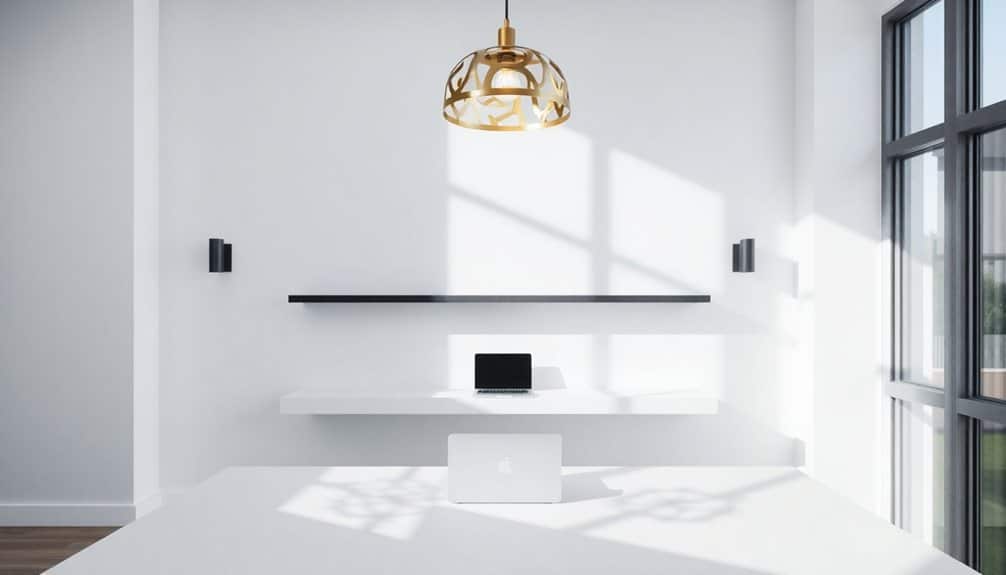
When selecting statement lighting for your home office, dramatic fixtures can transform an ordinary workspace into a sophisticated sanctuary. Consider sculptural pendant lights that double as artistic focal points, or sleek wall sconces that cast intimate pools of light across your workspace. Modern LED technology lets you adjust brightness and color temperature throughout the day, enhancing both productivity and ambiance.
Layer your lighting strategically to create depth and functionality in your office space. Position task lighting at your desk, ambient lighting for overall illumination, and accent lighting to highlight architectural features or artwork. Today’s trending fixtures embrace clean lines and mixed materials, from brass-and-glass combinations to matte black geometric shapes.
- Oversized arc floor lamps with marble bases and adjustable arms provide both drama and practicality while maximizing floor space
- Smart pendant clusters featuring mouth-blown glass in organic shapes offer customizable height configurations
- Linear LED wall fixtures with brushed metal finishes create contemporary appeal while delivering even, glare-free illumination
Choose fixtures that complement your existing decor while making a bold design statement. The right lighting becomes a functional art piece that elevates your entire home office aesthetic.
Decluttered Workspace Optimization
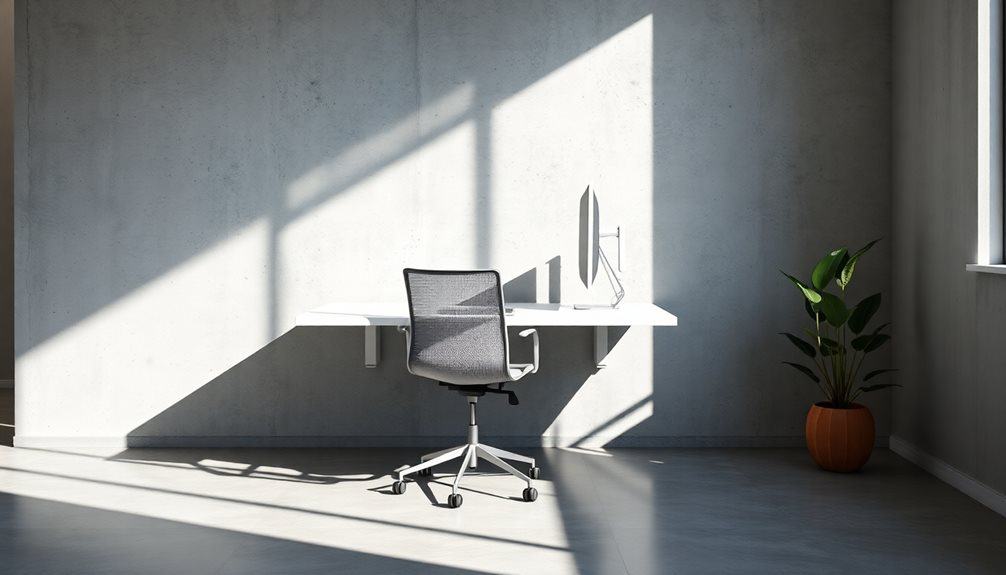
A clutter-free workspace forms the foundation of a stylish and productive home office. You’ll want to start by selecting a minimalist desk with built-in storage compartments that keep essential items within reach while maintaining clean lines. Install floating shelves at eye level to maximize vertical space and display only your most inspiring accessories.
Implement the “three-zone system” by dividing your desktop into active work, reference, and storage areas. Your active workspace should contain just your laptop or monitor, while the reference zone can house a sleek document stand. Utilize drawer organizers and cable management solutions to eliminate visual chaos beneath your workspace.
Consider investing in wireless peripherals to reduce cord clutter, and opt for a streamlined charging station that accommodates all your devices. Mount your monitor on an adjustable arm to free up valuable desk space and create a more ergonomic setup. Select storage solutions in matching finishes – think transparent acrylic or matte black containers – to maintain visual cohesion. Remember, every item should serve a purpose or contribute to your workspace’s aesthetic appeal.
Frequently Asked Questions
How Much Should I Budget for a Complete Minimalist Home Office Makeover?
You’ll want to budget $2,000-5,000 for a complete minimalist home office transformation. This covers essential pieces like a sleek desk ($300-800), an ergonomic chair ($200-500), refined storage solutions ($300-700), and minimalist lighting ($200-400). Don’t forget to allocate funds for clean-lined accessories, cable management, and potentially new paint or wallpaper to create that perfect serene workspace.
Can Minimalist Home Office Designs Work in Apartments With Strict Rental Policies?
You can absolutely create a stunning minimalist home office in a rental space by focusing on non-permanent solutions. Use freestanding furniture, slim-profile desk systems, and floating shelves with removable adhesive strips. Opt for cordless tech accessories, sleek desk lamps with clamp-on features, and lightweight room dividers. Consider minimalist storage solutions like wheeled filing cabinets and modular organizers that you’ll take with you when moving.
Which Minimalist Office Colors Are Best for Improving Productivity and Focus?
Studies show that color psychology directly impacts your work performance. You’ll find ideal focus with a neutral base of warm white or light gray, complemented by productivity-boosting accents. Try sage green for creativity and balance, soft blue for mental clarity, or muted terracotta for energy. Keep your palette limited to 2-3 colors max, ensuring each tone is desaturated to maintain that clean, minimalist aesthetic.
Are There Child-Friendly Minimalist Home Office Design Solutions Available?
You’ll find plenty of smart minimalist solutions that work well with kids. Consider raised storage units that keep important documents out of reach, washable wall paint in neutral tones, and rounded furniture corners for safety. Opt for spill-resistant fabrics on seating, and incorporate designated kid zones with clean-lined storage bins. Magnetic whiteboards double as both your planning space and their creative corner, while cable management systems prevent tangled hazards.
How Do I Maintain a Minimalist Aesthetic While Sharing Office Space?
While a shared office can feel chaotic, you’ll find balance through smart organization. Define your workspace with sleek room dividers or floating shelves that double as boundaries. Keep your zone clutter-free with hidden storage solutions and wireless tech. Opt for dual-purpose furniture like nesting tables or fold-down desks, and stick to a cohesive color palette that unifies the space while maintaining individual work areas.

